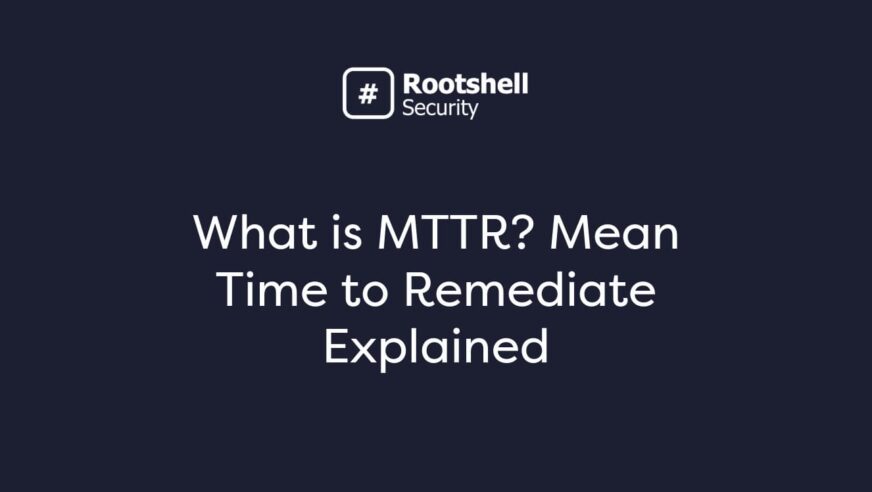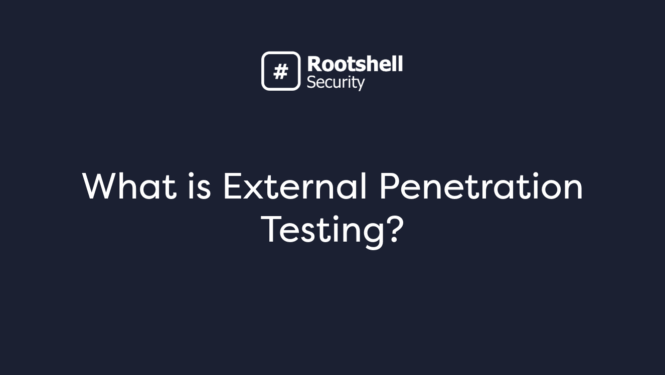In cybersecurity, speed is everything. The longer a vulnerability or security incident remains unresolved, the greater the potential for damage, whether that’s data loss, system downtime, reputational harm, or financial impact. Mean Time to Remediate (MTTR) is a key metric for measuring how quickly and effectively security teams respond to threats.. MTTR gives companies insights into their overall incident response effectiveness and can identify areas where processes, tools, or coordination need improvement.
This guide explores what MTTR is, why it matters, how it differs from other cybersecurity metrics, and strategies to help reduce remediation times.
What Is Mean Time To Remediate (MTTR)?
Mean Time to Remediate (MTTR) is a cybersecurity metric that measures the average amount of time it takes to detect, fix, and fully resolve a security vulnerability or incident.
MTTR is typically broken down into four stages:
- Detection – the time between when a failure occurs and when it is first identified.
- Diagnosis – the time required to analyze the issue and determine its root cause.
- Repair/Resolution – the time spent applying the fix.
- Verification/Testing – the time taken to confirm that the system is fully restored and operating correctly.
In cybersecurity, MTTR usually reflects the entire lifecycle of incident handling, from detection to resolution. A lower MTTR means faster recovery and less exposure to risk.
How to Reduce MTTR
Reducing MTTR requires a combination of technology, process optimization, and effective people management. Key strategies include:
Automation of response actions – Security orchestration and automated response tools can automatically contain threats, reducing manual workloads and response times.
Clear incident response playbooks – Standardized procedures help eliminate delays caused by uncertainty or inconsistent decision-making.
Continuous monitoring and alerts – Real-time visibility means faster detection, and quicker fixes.
Cross-team collaboration – Strong communication between IT, security, and operations teams accelerates issue resolution.
Regular training and simulation exercises – Practising response scenarios improves human performance and confidence during real incidents.
Why Is MTTR Important for Cybersecurity?
MTTR is one of the most important cybersecurity metrics because it measures how quickly an organisation can recover from a security incident or system failure. Here’s why it matters:
1. Limits Damage and Downtime
The longer a cyberattack or outage continues, the more damage it can cause, whether that’s stolen data, disrupted services, or financial losses. A lower MTTR means threats are contained and neutralized faster, reducing impact.
2. Protects Sensitive Data
Cybercriminals exploit the time gap between breach and response. A fast recovery reduces the “window of exposure” during which sensitive data can be accessed, stolen, or leaked.
3. Improves Business Continuity
For businesses that rely on digital operations, downtime equals lost revenue and customer trust. Reducing MTTR ensures systems are restored quickly, helping maintain continuity and compliance with SLAs.
4. Strengthens Incident Response Readiness
Tracking MTTR gives organizations insight into the effectiveness of their detection, response, and recovery processes. A consistently high MTTR signals gaps in tools, processes, or team coordination that need fixing.
5. Supports Compliance and Reporting
Many industries (finance, healthcare, etc.) have strict regulations on incident response and recovery times. Demonstrating a low MTTR can help prove compliance during audits.
6. Improves Customer and Stakeholder Confidence
Clients, partners, and regulators expect resilience. A strong MTTR reassures them that even if an incident occurs, the organization can bounce back quickly without major disruption.
How Do Human Factors Affect MTTR?
Human factors play a big role in Mean Time to Remediate (MTTR), as this metric isn’t just about the technical complexity of a system but also about how efficiently humans respond to incidents. Let’s break down the key ways human factors affect MTTR:
Skill and Experience of the Team: Highly skilled engineers or technicians can diagnose and fix issues faster, reducing MTTR. Less experienced staff may take longer due to trial-and-error approaches.
Availability and Response Time: MTTR increases if the right personnel are not immediately available to respond to incidents.
Communication and Collaboration: Poor communication or unclear escalation paths can delay resolution. If multiple teams are involved and coordination is slow, MTTR rises. Clear incident communication protocols help reduce delays.
Decision-Making and Problem-Solving: Deciding whether to patch, reboot, or replace a failing component affects downtime. Indecision or overly cautious approaches prolong MTTR.
Training and Documentation: Training and up-to-date runbooks allow teams to resolve issues faster. A documented troubleshooting guide for a specific server error can cut resolution time compared to teams relying on memory alone
In fact, the 2023 (ISC)² Cybersecurity Workforce Study found that organizations with formal training and career development achieve 22% faster incident remediation than those without.
Stress and Cognitive Load: High-pressure incidents can slow diagnosis and increase mistakes, extending MTTR.
Components That Influence MTTR
Mean Time to Remediate (MTTR) is shaped by a mix of technical, human, and process-related factors. Understanding these components can help organisations reduce downtime and improve system reliability.
Detection & Reporting
Incident detection: How quickly an issue is spotted. Faster detection lowers MTTR.
Incident reporting: The speed at which the problem is escalated to the right people.
Diagnosis & Troubleshooting
Fault identification: Pinpointing the root cause accurately.
Tools and access: Availability of diagnostic tools and system permissions speeds up the process.
Repair & Resolution
Repair time: The actual time engineers spend fixing the issue.
Replacement parts/resources: Having spares or backups on hand shortens delays.
Testing & Verification
Validation: Confirming the repair has resolved the issue without creating new ones.
Rollback plans: Contingency steps reduce downtime if fixes don’t work.
Human Factors
Skills and experience: Experienced staff solve problems faster.
Availability: On-call coverage and response time matter.
Collaboration and communication: Strong teamwork helps shorten MTTR.
Process & Documentation
SOPs: Clear procedures reduce trial-and-error.
Knowledge base: Access to past incidents speeds troubleshooting.
Escalation procedures: Ensures complex issues reach the right experts quickly.
Environmental & External Factors
Physical access: Remote or restricted sites can delay fixes.
External dependencies: Vendor or supply chain delays increase MTTR.
How to Measure MTTR Accurately
To calculate MTTR, use this formula:

Best practices for accurate measurement:
- Define clear start and end points (e.g., detection vs. full remediation).
- Exclude outliers that don’t reflect normal operations.
- Track MTTR separately for different incident types.
- Use consistent monitoring and logging tools.
Common Pitfalls to Avoid in Cybersecurity MTTR Calculation:
- Unclear definitions – whether MTTR means repair, respond, or remediate.
- Ignoring partial fixes – only measuring service restoration, not full remediation.
- Skewed averages – letting one unusually long or short incident distort results.
- Overemphasis on speed – rushing can cause incomplete fixes, leading to repeat incidents.
How Does Company Size and Complexity Affect MTTR Benchmarks?
MTTR benchmarks are not universal; they vary depending on an organization’s size and the complexity of its IT environment. A small business with a straightforward infrastructure will naturally have different expectations than a global enterprise with multiple interconnected systems.
Small to Medium-Sized Businesses (SMBs)
Simpler environments: Fewer applications, endpoints, and integrations mean issues are often easier to diagnose and fix.
Smaller teams: Smaller IT or DevOps teams may have limited round-the-clock coverage, which can extend repair times.
Lower benchmarks: For SMBs, an acceptable MTTR may range from minutes to a few hours, depending on the criticality of the system.
Large Enterprises
Complex infrastructure: Multi-cloud setups, hybrid networks, and legacy systems increase fault identification and resolution times.
Specialized teams: Enterprises often have dedicated incident response teams, escalation procedures, and automated tooling to streamline fixes.
Faster MTTR: According to the 2024 Ponemon Institute Cost of a Data Breach Report, enterprises with dedicated security teams often achieve 30–40% faster MTTR than mid-market companies, largely due to specialized expertise and tool investments.
Higher expectations: While complexity slows resolution, strong resources and processes mean benchmarks are often stricter, downtime has higher financial and reputational costs.
The Future of Cybersecurity MTTR
The approach to managing Mean Time to Remediation (MTTR) is changing. As threats become more sophisticated and organizations increasingly rely on complex, interconnected systems, reducing MTTR is becoming a priority.
Predictive Analytics
Instead of reacting to incidents, predictive analytics can identify potential vulnerabilities before they become a real issue. Organizations can take pre-emptive actions that lower MTTR and avoid incidents altogether.
Integrated Security Platforms
Future cybersecurity strategies will rely on unified platforms that combine monitoring, incident response, and threat intelligence. Centralised dashboards and real-time alerts enable faster diagnosis and coordinated response across teams.
According to the 2023 SANS Institute Threat Intelligence Survey, organizations with threat intelligence programs integrated into their incident response workflows achieve 28–35% faster MTTR compared to those relying solely on internal event data. This highlights the value of combining actionable intelligence with automated and streamlined response processes to accelerate remediation and reduce risk.
Rootshell Security’s platform provides a solution that integrates various cybersecurity functions. Our platform consolidates data from penetration test reports and leading assessment tools, streamlining remediation workflows from start to finish.
Continuous Improvement and Benchmarking
The future will see more adaptive MTTR benchmarks based on organizational complexity. Continuous monitoring, automated reporting, and data-driven insights will help organizations refine processes, reducing MTTR over time.
Automation and AI-Driven Remediation
Automation is changing the way we respond to weaknesses, and its role will only grow. AI and machine learning can detect anomalies, prioritize threats, and even initiate automated remediation steps.
The 2023 Ponemon Institute State of Security Operations study found that organizations using AI-driven security analytics reduce their overall MTTR by 37% compared to traditional manual approaches, while also improving the thoroughness of remediation. This demonstrates the tangible benefits of integrating AI into security operations.
Speed up MTTR with Rootshell Security’s Automation Center
Reducing Mean Time to Remediate relies not just on processes and people, but on smart automation. Rootshell Security’s Automation Center exemplifies this approach, allowing organizations to speed up vulnerability management.
With its intuitive process builder, security teams can set up custom automation rules in minutes, tackling repetitive tasks such as prioritising vulnerabilities, assigning issues, and creating tickets. Powerful triggers allow organizations to automatically manage vulnerabilities, ensuring high-priority issues are never overlooked.
The Automation Center reduces manual effort and shortens MTTR by prioritising vulnerabilities based on organizational context rather than CVSS scores alone, and handling hundreds of lower-severity issues.
Reduce MTTR to Protect Your Business and Customers
Reducing MTTR requires a combination of technology, well-defined processes, and skilled personnel. With the right investments, you can not only lower incident recovery times but also build long-term trust with your customers, regulators, and stakeholders.
Ready to improve your MTTR and overall security posture? Book a demo with RootShell Security today.
Frequently Asked Questions
Can’t find the answer to your question?
You can always Contact Our Team of experts for a chat!
What is a good MTTR benchmark?
It varies by industry, size, and infrastructure complexity. In cybersecurity, faster is always better, but benchmarks often range from a few hours to under 24 hours.
Does automation reduce MTTR?
Yes. Automation helps contain threats instantly and speeds up remediation steps. However, human expertise is still important in complex cases.
What happens if MTTR is too high?
Long MTTR increases the risk of prolonged downtime, larger data breaches, and higher recovery costs. It can also affect compliance with regulations like GDPR.
Is MTTR the same as downtime?
Not exactly. MTTR measures the average time to repair, while downtime is the total time a system is unavailable. MTTR is one metric used to understand and reduce downtime.
Can MTTR vary by incident type?
Yes. Some incidents are easier to diagnose and resolve, like minor software bugs, while others, such as complex system failures or multi-layered cybersecurity breaches, can take much longer.



